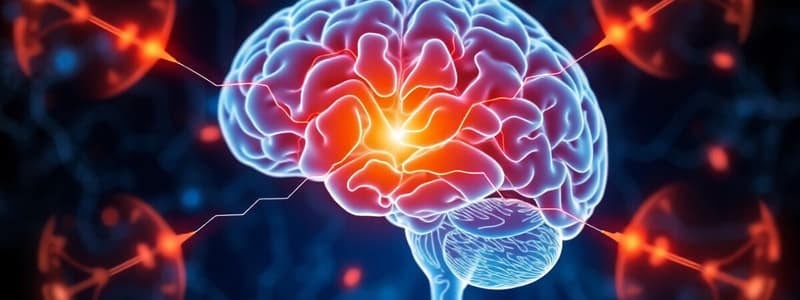Podcast
Questions and Answers
What is the primary function of the anterior auditory pathway?
What is the primary function of the anterior auditory pathway?
- Identifying the identity of sounds (correct)
- Processing auditory-visual interactions
- Identifying where sounds are located
- Facilitating conductive deafness
Which type of deafness is caused by damage to the ossicles?
Which type of deafness is caused by damage to the ossicles?
- Sensorineural deafness
- Nerve deafness
- Conductive deafness (correct)
- Age-related hearing loss
Damage to which auditory pathway results in difficulties with sound localization?
Damage to which auditory pathway results in difficulties with sound localization?
- Primary auditory areas
- Auditory-visual areas
- Posterior pathway (correct)
- Anterior pathway
In age-related hearing loss, which part of the cochlea is primarily affected?
In age-related hearing loss, which part of the cochlea is primarily affected?
What type of neurons in the posterior parietal area can have both visual and auditory receptive fields?
What type of neurons in the posterior parietal area can have both visual and auditory receptive fields?
What structure is located in the outer ear?
What structure is located in the outer ear?
Which of the following represents the order of auditory signal processing from the ear to the primary auditory cortex?
Which of the following represents the order of auditory signal processing from the ear to the primary auditory cortex?
What is the primary function of the oval window in the inner ear?
What is the primary function of the oval window in the inner ear?
Which area of the brain surrounds the primary auditory cortex?
Which area of the brain surrounds the primary auditory cortex?
In which part of the auditory pathway is sound information integrated?
In which part of the auditory pathway is sound information integrated?
What is the primary function of the auditory system?
What is the primary function of the auditory system?
Which type of sensory cortex receives input directly from the thalamus?
Which type of sensory cortex receives input directly from the thalamus?
What does hierarchical organization in sensory systems refer to?
What does hierarchical organization in sensory systems refer to?
What characterizes functional segregation in the sensory cortex?
What characterizes functional segregation in the sensory cortex?
What is parallel processing in the context of sensory information?
What is parallel processing in the context of sensory information?
What are sound vibrations perceived by the auditory system?
What are sound vibrations perceived by the auditory system?
Which sensory cortex receives input from more than one sensory system?
Which sensory cortex receives input from more than one sensory system?
What was a common misconception about sensory system organization in the past?
What was a common misconception about sensory system organization in the past?
Flashcards
Anterior Auditory Pathway
Anterior Auditory Pathway
The part of the auditory cortex responsible for identifying what a sound is. This pathway helps us understand the characteristics of a sound like its pitch, tone, or timbre.
Posterior Auditory Pathway
Posterior Auditory Pathway
The part of the auditory cortex responsible for determining where a sound is coming from. This pathway helps us locate the source of a sound in space.
Auditory-Visual Interactions
Auditory-Visual Interactions
The way our brain combines information from our hearing (auditory) and sight (visual) senses for a more complete understanding of our environment. This occurs in both primary and association areas of the brain.
Conductive Deafness
Conductive Deafness
Signup and view all the flashcards
Nerve Deafness
Nerve Deafness
Signup and view all the flashcards
What are the three bones of the middle ear?
What are the three bones of the middle ear?
Signup and view all the flashcards
What is the organ of Corti?
What is the organ of Corti?
Signup and view all the flashcards
What is the path of auditory information to the primary auditory cortex?
What is the path of auditory information to the primary auditory cortex?
Signup and view all the flashcards
What is tonotopic organization?
What is tonotopic organization?
Signup and view all the flashcards
What is the role of the auditory association cortex?
What is the role of the auditory association cortex?
Signup and view all the flashcards
Primary Sensory Cortex
Primary Sensory Cortex
Signup and view all the flashcards
Secondary Sensory Cortex
Secondary Sensory Cortex
Signup and view all the flashcards
Association Sensory Cortex
Association Sensory Cortex
Signup and view all the flashcards
Hierarchical Organization in Sensory Systems
Hierarchical Organization in Sensory Systems
Signup and view all the flashcards
Functional Segregation in Sensory Systems
Functional Segregation in Sensory Systems
Signup and view all the flashcards
Parallel Processing in Sensory Systems
Parallel Processing in Sensory Systems
Signup and view all the flashcards
Auditory System Function
Auditory System Function
Signup and view all the flashcards
Physical vs. Perceptual Dimensions of Sound
Physical vs. Perceptual Dimensions of Sound
Signup and view all the flashcards
Study Notes
Lecture 7: Other Sensory Systems
- The lecture focuses on auditory and somatosensory systems.
- Required reading is Chapter 7.
Learning Objectives
- Define the three types of sensory cortex.
- Explain hierarchical organization, functional segregation, and parallel processing in the context of sensory system organization.
- Summarize the current model of sensory system organization.
Three Types of Sensory Area of Cortex
- Primary sensory cortex receives input directly from the thalamus.
- Secondary sensory cortex gets input from the primary sensory cortex.
- Association sensory cortex gets input from more than one sensory system.
Features of Sensory System Organization
- Hierarchical organization: Information flows through brain structures in order of increasing complexity. Damage to different levels has specific effects that show this pattern.
- Functional segregation: Different levels of the sensory system (primary, secondary, association) specialize in distinct types of analysis.
- Parallel processing: Information flows simultaneously along multiple pathways between structures.
Former and Current Models of Sensory System Organization
- Older models viewed sensory processing as serial (one pathway) and homogeneous (all parts working together).
- Modern models recognize hierarchical organization but with functional segregation (different areas specialized for different functions) and parallel processing (simultaneous pathways).
Learning Objectives (Auditory System)
- Explain the relationship between physical and perceptual dimensions of sound.
- Describe the parts of the human ear and how sound is processed.
- Detail the pathways from the ear to the primary auditory cortex.
- Describe auditory cortex organization.
- Explain the effects of damage to the auditory system.
Auditory System
- The auditory system detects sound, which is vibrations of air molecules.
Physical and Perceptual Dimensions of Sound
- Amplitude: Related to sound loudness. Higher amplitude = louder sound.
- Frequency: Related to wavelength of sound; perceived as pitch. Higher frequency = higher pitch.
- Complexity: Refers to the mixture of frequencies in a sound; this determines timbre (quality of sound).
Anatomy of the Ear
- Outer ear: The pinna and auditory canal.
- Middle ear: The tympanic membrane (eardrum), ossicles (hammer, anvil, stirrup).
- Inner ear: The oval window, cochlea (fluid-filled structure), hair cells on the basilar membrane, tectorial membrane.
Auditory Receptors
- Hair cells in the cochlea are the receptors for sound.
Pathway from Ear to Primary Auditory Cortex
- Hair cells stimulate auditory nerves.
- Signals project to the metencephalon.
- Then to midbrain structures (inferior colliculi).
- From there to the medial geniculate nucleus (thalamus).
- Finally to the primary auditory cortex.
Organization of the Auditory Cortex
- Receives input from the medial geniculate nucleus (thalamus).
- Primary auditory cortex is surrounded by the belt area (secondary auditory cortex).
Tonotopic Organization
- A way the brain organizes sound frequencies. Areas in the auditory cortex are specialized for different sound frequencies with higher-pitched sounds closer to areas of higher frequency processing in the brain.
Natural sounds optimal for Studying Auditory Cortex
- Using natural sounds is better for studying the auditory cortex because it shows the real complexity of sound.
Organization of the Association Cortex
- Integrates auditory information from prefrontal and posterior parietal cortex.
- Two auditory pathways:
- Anterior pathway: Identifies sound.
- Posterior pathway: Locates the source of sound.
Anterior and Posterior Auditory Pathways
- Anterior pathway: In the prefrontal cortex, identifies the sounds
- Posterior pathway: In the posterior parietal cortex, identifies the location of sounds
Auditory-Visual Interactions
- Auditory-visual interactions are important for sensory processing
- Auditory-visual interactions occur in association areas, as well as the primary areas.
- Some neurons in the posterior parietal cortex have receptive fields for both visual and auditory stimuli.
Effects of Damage to the Auditory System
- Auditory cortex damage:
- Damage to the anterior ("what" pathway) affects sound identification.
- Damage to the posterior ("where" pathway) affects sound localization.
Deafness in Humans
- Total deafness is rare.
- Conductive deafness: Damage to ossicles.
- Nerve deafness: Damage to the cochlea or nerve, loss of hair cells
- Age-related hearing loss is common- often the hair cells/cochlea are involved.
Studying That Suits You
Use AI to generate personalized quizzes and flashcards to suit your learning preferences.




